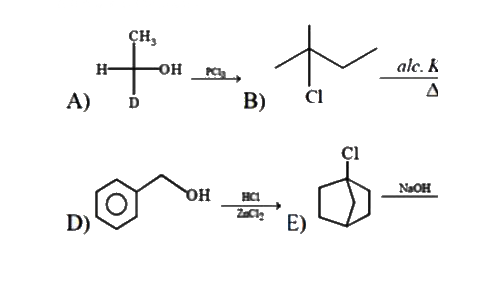Explain why nucleophilic substitution reactions rae not very common in phenols.
To explain why nucleophilic substitution reactions are not very common in phenols, we can break down the reasoning into several steps:
1. Understanding the Structure of Phenols:
- Phenols are compounds where a hydroxyl group (-OH) is directly attached to an aromatic ring. The aromatic ring consists of sp² hybridized carbon atoms, which are part of a conjugated π-electron system.
2. Resonance Stabilization:
- The hydroxyl group in phenols can participate in resonance with the aromatic ring. This means that the lone pair of electrons on the oxygen can delocalize into the π-system of the ring, creating a partial double bond character between the oxygen and the carbon atom to which it is attached. This resonance stabilization makes the O-H bond stronger and less reactive.
3. Comparison with Alcohols:
- In alcohols, the hydroxyl group is attached to sp³ hybridized carbon atoms, which do not have the same resonance stabilization as in phenols. As a result, the O-H bond in alcohols is weaker and more reactive compared to that in phenols.
4. Nucleophilic Substitution Mechanism:
- Nucleophilic substitution reactions typically involve the attack of a nucleophile on a carbon atom that is bonded to a leaving group. In phenols, the carbon atom bonded to the -OH group is sp² hybridized, which means it has a planar structure and a higher electron density due to resonance. This makes it less susceptible to nucleophilic attack.
5. Steric Hindrance:
- Additionally, the bulky nature of the aromatic ring can create steric hindrance, further preventing nucleophiles from effectively approaching and attacking the carbon atom bonded to the hydroxyl group.
6. Conclusion:
- Therefore, due to the resonance stabilization of the O-H bond and the steric hindrance presented by the aromatic ring, nucleophilic substitution reactions are not very common in phenols compared to alcohols.
- Phenols are compounds where a hydroxyl group (-OH) is directly attached to an aromatic ring. The aromatic ring consists of sp² hybridized carbon atoms, which are part of a conjugated π-electron system.
- The hydroxyl group in phenols can participate in resonance with the aromatic ring. This means that the lone pair of electrons on the oxygen can delocalize into the π-system of the ring, creating a partial double bond character between the oxygen and the carbon atom to which it is attached. This resonance stabilization makes the O-H bond stronger and less reactive.
- In alcohols, the hydroxyl group is attached to sp³ hybridized carbon atoms, which do not have the same resonance stabilization as in phenols. As a result, the O-H bond in alcohols is weaker and more reactive compared to that in phenols.
- Nucleophilic substitution reactions typically involve the attack of a nucleophile on a carbon atom that is bonded to a leaving group. In phenols, the carbon atom bonded to the -OH group is sp² hybridized, which means it has a planar structure and a higher electron density due to resonance. This makes it less susceptible to nucleophilic attack.
- Additionally, the bulky nature of the aromatic ring can create steric hindrance, further preventing nucleophiles from effectively approaching and attacking the carbon atom bonded to the hydroxyl group.
- Therefore, due to the resonance stabilization of the O-H bond and the steric hindrance presented by the aromatic ring, nucleophilic substitution reactions are not very common in phenols compared to alcohols.
Similar Questions
Knowledge Check
Which one is a nucleophilic substitution reaction among the following ?
ARCHO+R'Mgx→R−C∣OHH−RBCH3−CH2−oevrset(CH3)∣CH−CH2Br+NH3→CH3−CH2−CH3∣CH−CH2NH2CCH3CHO+HCN→CH3CH(OH)CNDCH3−CH=CH2+H2OH+−−→CH3−C∣OHH−CH3Consider the following anions.

When attached to sp -hybridized carbon, their leaving group ability in nucleophilic substitution reaction decreases in the order :AI gt II gt III gt IVBI gt II gtIV gt IIICIV gt I gt II gt IIIDIV gt III gt II gtIRate of substitution reaction in phenol is :
Aslower than the rate of benzeneBfaster than the rate of benzeneCequal to the rate of benzeneDnone of these
Explain why are electrophilic substitution reactions the most characteristic reactions of benzene?
View SolutionChlorobenzene is extremely less reactive towards nucleophilic substitution reaction. Give two reasons for the same.
View SolutionAryl halides are practically inert toward nucleophilic substitution reactions . The reasons for this fact are
(a) Because C -X bond has partial double bond character due to conjugation bewteen lone pair of X and π electrons of aromatic ring .
(b) No S N 1 reaction beacuase aryl carbocations are unstable
(c) No S N 2 reaction because aromatic π electron cloud do not allow backside attack of N u −
(d) Product obtained through nucleophilic substitution reactions are non aromatic
View SolutionIdentify number of nucleophilic substitution reactions in the given reactions?

View SolutionAryl halides are less reactive towards nucleophilic substitution reaction as compared to alkyl halides due to
View Solution
